Kids Web Japan
Web Japan > Kids Web Japan > Meet the Kids > Chado > Matcha and Temae
Meet the Kids
Chado or Sado
(Tea Ceremony)
Matcha and Temae
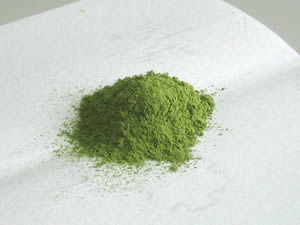
Matcha is a dark green powder.
Matcha
The tea that is used in chado is matcha, a powdered tea made from tea leaves. Matcha is made in a different way than regular Japanese tea. When new leaves begin sprouting on the tea trees, the trees are covered over so that direct sunlight does not reach them. This gives the tea a peculiar sweetness and clear taste. After the tea shoots are harvested, they are steamed and dried, and the stems are removed. Finally, the remaining leaves are ground into powder, resulting in matcha.
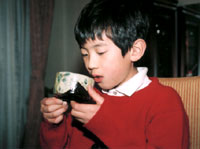
The guest must concentrate on the tea when drinking it.
Matcha is brewed by adding some powder directly into a drinking bowl, pouring hot water over it, and stirring with a chasen, or bamboo whisk. So'oku says, "When you drink something like Western tea, you can chat or eat while you drink. But when you drink matcha in chado, you sit on your legs, hold the bowl in both hands, and concentrate on the act of drinking until you're done, without putting the bowl down halfway. Tea becomes your sole purpose during that moment. I think that's what makes it different from ordinary tea."
Temae
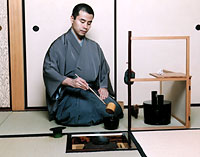
Pouring hot water into the tea bowl.
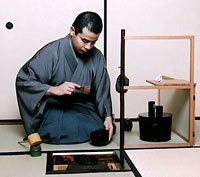
Cleaning the utensils and bowl, then warming the bowl.
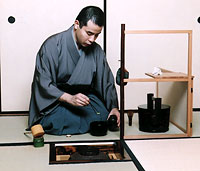
Putting matcha into the bowl.
One obvious characteristic of chado is that the host makes the tea in front of the guests. The procedure of making tea is known as temae, and it is an important series of motions that students of chado practice over and over.
Briefly, here is how a temae proceeds. First, the host cleans the tea-making utensils and drinking bowl, and then warms the bowl with hot water. After removing this water, matcha powder is added to the bowl, fresh hot water is poured in, and the contents are stirred with a whisk. The host then offers the tea to the guest. Finally, all the utensils that were used are cleaned once again and put back to where they were in the beginning. There is a proper place for every utensil and a proper way to handle each of them.
From the time of Rikyu four centuries ago, the temae has been handed down by generations of tea masters. The motions with which matcha is brewed are efficient, effective, and have a flowing beauty.